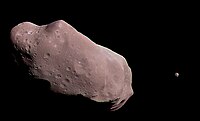
Photo from wikipedia
This article presents a feasibility study on the transmission of information through the biological tissues exploiting light. The experimental results demonstrating the potentials of optical wireless communications through biological tissues… Click to show full abstract
This article presents a feasibility study on the transmission of information through the biological tissues exploiting light. The experimental results demonstrating the potentials of optical wireless communications through biological tissues (OCBT) are presented. The main application of the proposed technology is in-body communications, where wireless connectivity needs to be provided to implanted electronic devices, such as pacemakers, cardiac defibrillators, and smart pills, for instance. Traditionally, in-body communications are performed using radio and acoustic waves. However, light has several fundamental advantages making the proposed technology highly attractive for this purpose. In particular, optical communications are highly secure, private, safe, and in many cases, extremely simple with the potential of low-power implementation. In the experiments, near-infrared light was used, as the light propagation in biotissues is more favorable in this part of the spectrum. The amount of light exposure given to biotissues was controlled to keep it within the safety limits. Information transmission experiments were carried out with the temperature-controlled ex vivo samples of porcine tissue. The tissue temperature was found to be significantly affecting the light propagation process. Communication performance with respect to the biotissue thickness and light direction was assessed. The results showed that optical channels to and from the possible implant are nearly reciprocal. Communication links were established to the deepness of more than four centimeters, and the data rates of up to 100 Kbps were obtained. The encouraging results of this study allow us to anticipate the potential applications of the proposed light-based technology to communicate with the various electronic devices implanted at different depths in the human body.
Journal Title: IEEE Access
Year Published: 2020
Link to full text (if available)
Share on Social Media: Sign Up to like & get
recommendations!